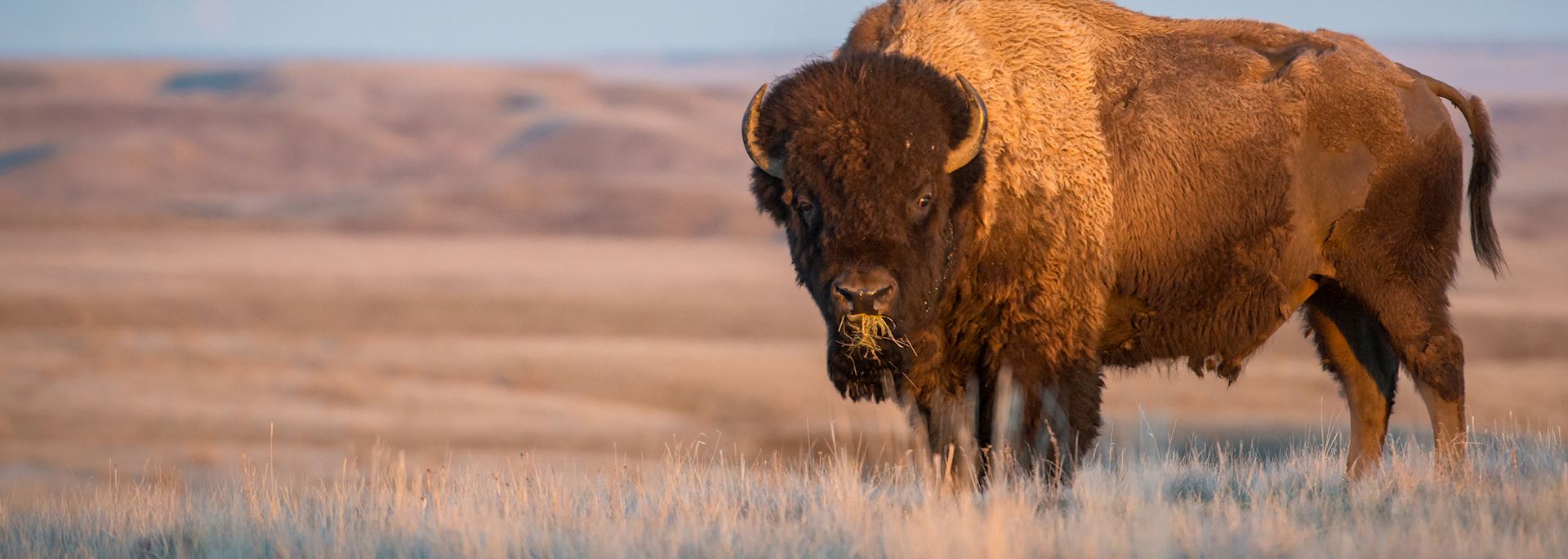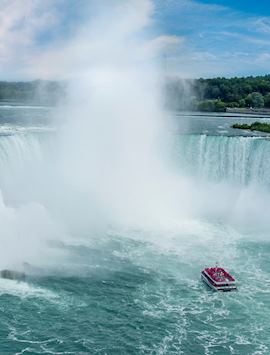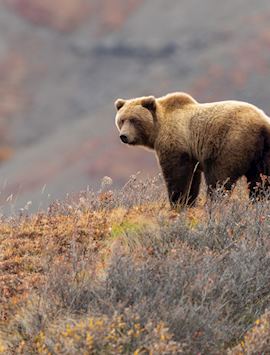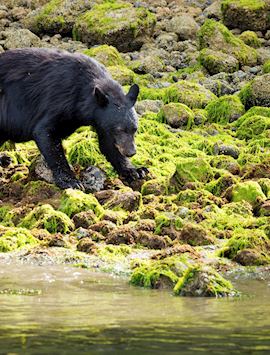From gold-tinged prairies to vine-covered valleys, fossil-strewn badlands to coastal rainforest, there’s more to Canada than its flagship lakes and mountains. Whether it’s your first visit or your fifth, we can suggest new ways for you to experience the landscapes, culture, and wildlife of this vast and varied land.
You could immerse yourself in ranch life in Saskatchewan, learning to wrangle cattle and riding horseback across swaying grassland. Snorkel or dive among shipwrecks long claimed by the treacherous waters of Ontario’s Lake Huron. Or, stay overnight at a remote lighthouse along Newfoundland’s iceberg-strewn coastline.
Wine tasting in the Okanagan Valley, British Columbia
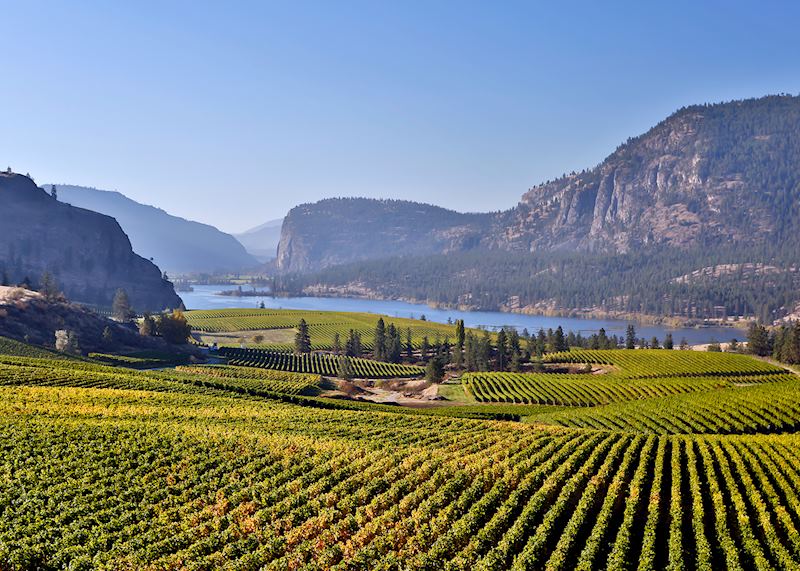
To the south of British Columbia, the Okanagan Valley is the driest and warmest region of Canada, providing ideal conditions for grape growing. Vines thread the gentle hillsides, helping to produce sun-ripened reds, crisp whites, and sweet ice wines. This variety is thanks to four sub-regions, each with a different soil type, climate and landscapes — you’ll find glittering lakes, fertile green hills, and, most surprisingly, desert.
We suggest staying for two or three nights here, calling in at a few local wineries to enjoy some tastings and find out more about the wine-making process. We like Quails’ Gate Winery, which has been owned by three generations of the same family since it was established in 1956. As well as touring the vineyard and going behind the scenes in its cellars, you can sit down for a wine-paired meal in its Old Vines Restaurant, which uses local ingredients.
Searching for fossils in Dinosaur Provincial Park, Alberta
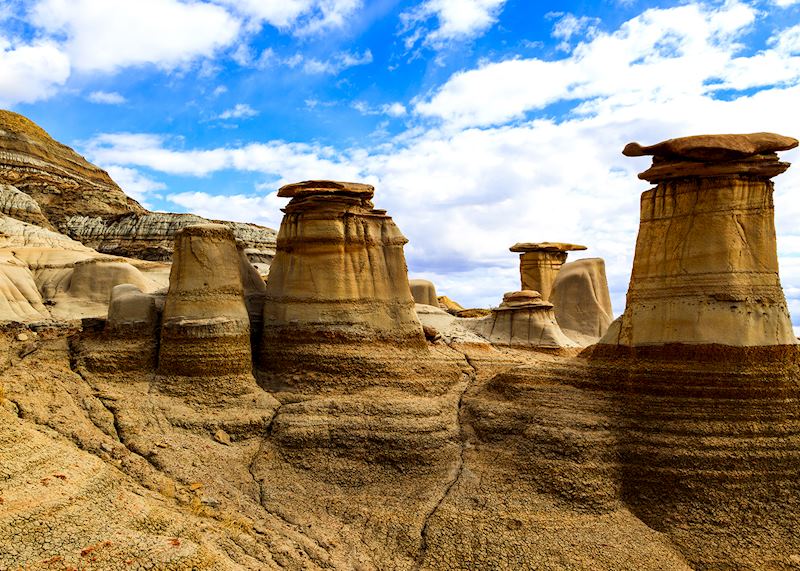
Ochre canyons dotted with bristly scrub and prickly pear cacti, twisted sandstone hoodoos (rock spires), and the feeling that you could stumble upon a dinosaur footprint, bone, or fossil at any moment… Dinosaur Provincial Park, within the Canadian Badlands, has a landscape few picture when thinking about Canada.
Nowhere on Earth has the same quantity and quality of prehistoric remains been found, and palaeontologists continue their digs and discoveries in this UNESCO World Heritage Site today. Easily accessible from Calgary, the park gives you the chance to explore the region’s geology, history, flora, and fauna.
Visit the interpretive facility for in-depth insights, and head to the nearby town of Drumheller, which hosts an annual Dinofest celebration in June. You’ll find the Royal Tyrrell Museum here, where scientists will tell you about the process of fossil discovery. You can also hunt for fossils yourself by joining a guided 3 km (1.9 mile) walk through the park, pausing to see ancient petroglyphs (rock art), horned lizards, and myriad birdlife.
Experiencing Saskatchewan’s prairies & ranch life
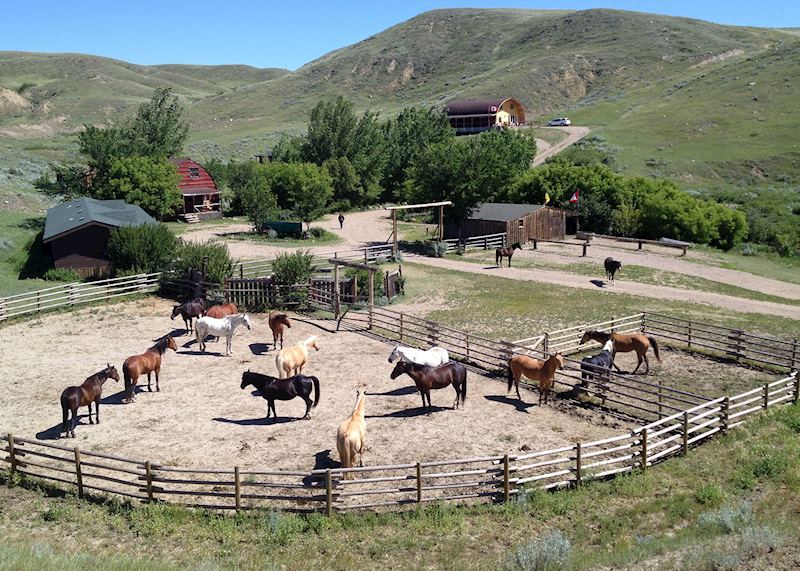
Time seems to be on pause in the sprawling central province of Saskatchewan. In Grasslands National Park, you’ll see bison dotting the golden prairies in scenes that have remained unchanged for millennia. You can explore this vast, wind-whipped wilderness — one of North America’s last surviving grasslands — by driving the two scenic highways that cut through the park. Pause to explore walking trails and see some of the 300 bison that have thrived here since the animals were reintroduced in 2006. You might also spot black-tailed prairie dogs, short-horned lizards, foxes, pronghorn, and prairie rattlesnakes.
The dazzling vistas here don’t end at night — look up and you’ll see why this is the country’s darkest Dark Sky Preserve. I like to download a stargazing app to help me identify the constellations shining overhead.
For an insight into life on the prairies, you could spend a few nights at a working cattle ranch. We recommend La Reata Ranch on the shores of Lake Diefenbaker, where the owner, George, will show you how to wrangle and care for his large herd. Other activities include horse riding, canoeing, fishing, and hiking while keeping your eyes peeled for golden eagles soaring above. Then, in the evening, toast marshmallows and trade stories around the campfire.
Seeing the Mounties in Saskatchewan

Fondly referred to as the Mounties, the Royal Canadian Mounted Police (RCMP) have enforced law and order across Canada since 1873, and their crimson uniform has become a familiar sight at events across the country and further afield.
You can visit their headquarters in the provincial capital, Regina, where more than 1,000 cadets complete their training each year. Exhibits give you an insight into their history, traditions, and present-day operations. Best of all, if you’re visiting in July or August, you might get to watch the Sunset Retreat Ceremony, when the cadets parade past in their regalia to the sound of bagpipes and their own boots moving in synchrony.
Chasing the northern lights in the Yukon
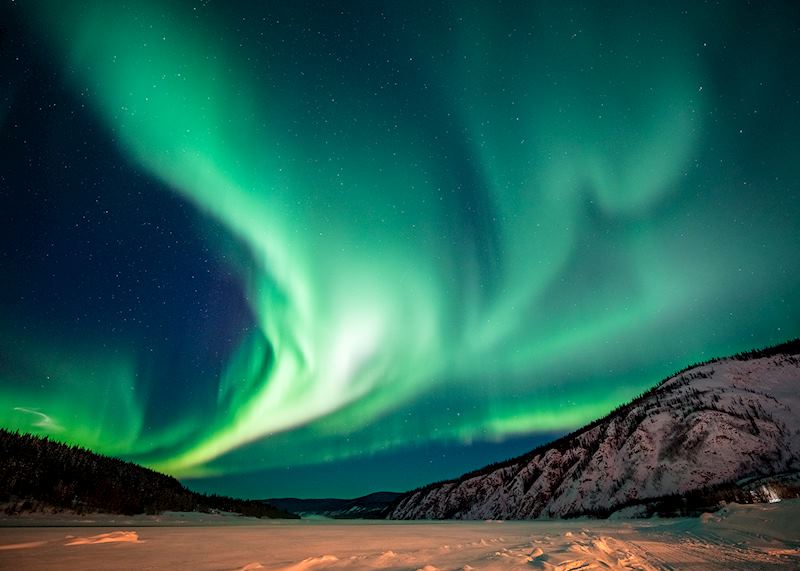
As you wait in the crisp night air, a steaming mug of hot chocolate to warm you, the perfect darkness of the sky above is interrupted by a greenish-yellow ribbon of light wavering among the stars. Lasting anything from a few captivating seconds to hours, the northern lights are perhaps mostly associated with the North Pole. But, they also bloom across the northerly reaches of Canada, including the remote Yukon Territory. Your best chance of seeing them is between midnight and 3am in the colder, darker months of November to March.
You also need to get away from any light pollution from larger settlements. We recommend staying in a wilderness lodge like Northern Lights Resort and Spa, whose log cabins and glass-fronted chalets sit surrounded by pine forest in the Yukon River Valley. If the lights show, you can watch in awe with other guests on the large deck, or witness them from the comfort of your own cabin.
You can read more about seeing the northern lights in Canada in our guide.
Snorkelling among shipwrecks in Fathom Five National Marine Park Ontario
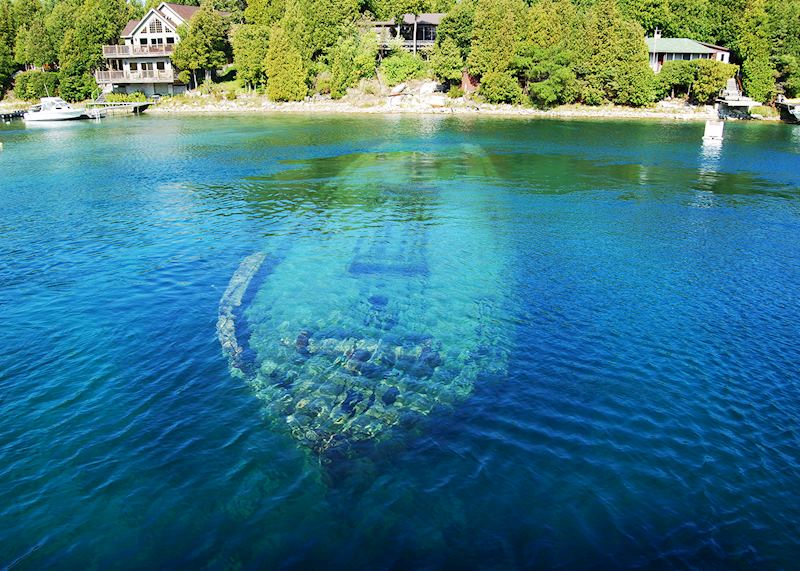
Situated at the northern tip of the Bruce Peninsula, within Lake Huron, Fathom Five’s freshwater ecosystem provides a habitat for diverse wildlife and plant life, from red squirrels and bears to calypso orchids. But, it’s what lies beneath the clear waters that attracts snorkelers and divers to this area of Ontario.
The treacherous sailing conditions sank many ships in the late-19th and early 20th centuries, while further vessels have been intentionally sent to a watery grave, creating an underwater playground for divers. You can also take a glass-bottomed boat to view the ghostly ships from above while your guide tells you the history behind them. And, if it’s warm enough, you could enter the water to snorkel over them.
Elsewhere on the peninsula, you can visit the lighthouses stationed to try to prevent these maritime disasters. Big Tub Lighthouse has stood sentry at the entrance to Tobermory’s port since 1885 — while it’s been rebuilt and renovated over the years, it still has its classic red-and-white structure. There’s also Cabot Head Lighthouse, which has a small museum and interpretive trails that let you learn about its history while taking in views over Georgian Bay.
Spotting wildlife on & around the Gaspé Peninsula, Québec
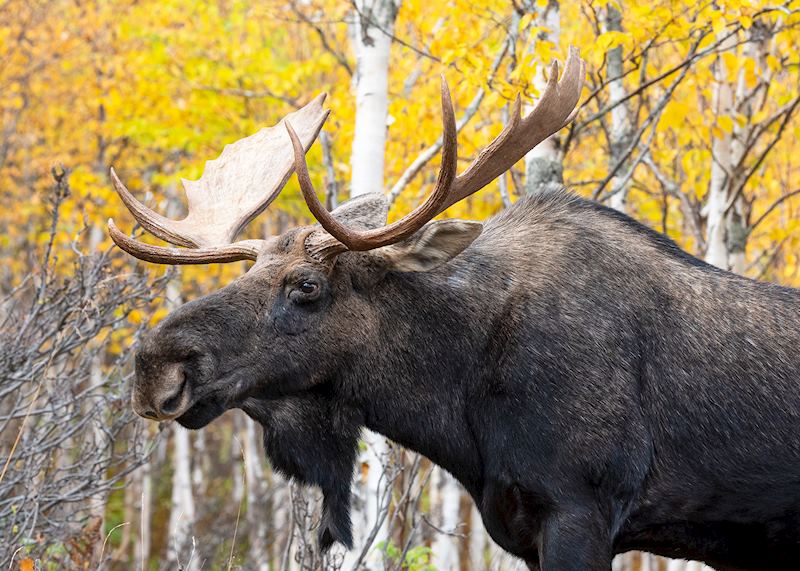
This finger of land jutting into the Gulf of St. Lawrence encompasses several national parks and has a coastline strewn with rock formations and winking lighthouses. To get there, you can drive along the coast from Québec City or take a ferry across from Saguenay, on the opposite side of the St. Lawrence River.
We suggest driving a loop around the peninsula over the course of three or four days so you can explore the region in depth. You can hop between some of the 40 or so lighthouses, explore quiet seaside towns and their lengthy beaches, and take a boat trip out to see the peninsula’s most photographed rock formation, the limestone arch of Percé Rock. You’ll then sail to Île-Bonaventure-et-du-Rocher-Percé National Park to set eyes on one of the planet’s largest northern gannet colonies.
Inland, visit Gaspésie National Park, where the coastal scenery is swapped for the forest-covered Chic-Choc Mountains, which are laced with hiking trails, and shimmering lakes where you can paddle a canoe. While there, look out for moose, caribou, and grey foxes, among other wildlife.
Getting to know Acadian history & culture in Caraquet, New Brunswick
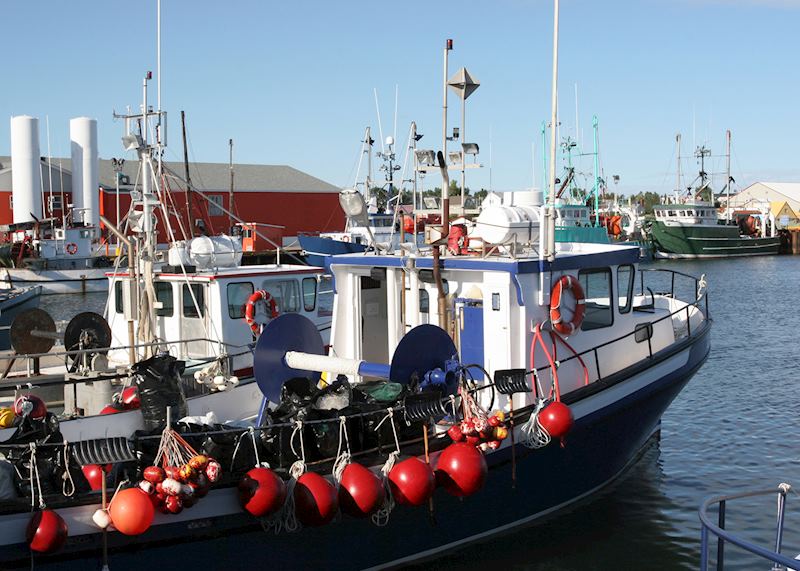
Founded by Acadian French refugees from Nova Scotia in 1757, the town of Caraquet, on New Brunswick‘s Acadian Peninsula, may be small, but it has a vibrant artistic community, lively festivals, and a thriving port. One of the province’s oldest French settlements, its food, folklore, music, and language are slightly distinct from other French-Canadian areas, and parts of it feel as though time has stood still.
You can explore its heritage and culture at the waterfront Musée Acadien de Caraquet, which has an enlightening collection of photos, letters, and historical items that paint a picture of early life here.
Alternatively, just outside the town, Le Village Historique Acadien is an open-air museum with more than 50 historic buildings dating as far back as 1773, including log-cabin homes, mills, farm buildings, and a blacksmith’s workshop. Guides wear traditional Acadian costumes to help set the scene as they talk you through what life was like for early settlers, and you can follow a 2.2 km (1 mile) route lined with period shops that includes a Victorian covered bridge.
If you’re visiting in August, you might stumble upon the Festival Acadien de Caraquet, a celebration of Acadian heritage with music and parades.
Exploring dunes & lagoons in Kouchibouguac National Park, New Brunswick
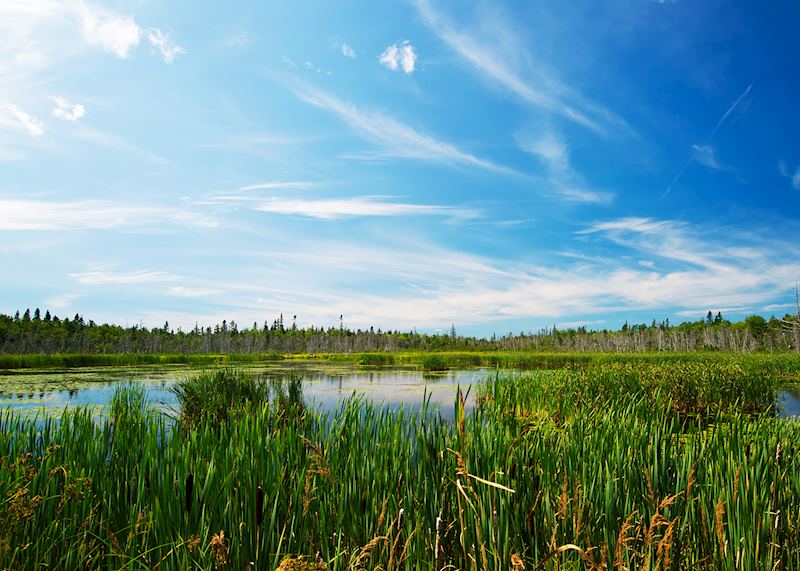
Wildlife-rich salt marshes, sparkling lagoons, dense mixed forest, and golden dunes… Kouchibouguac National Park, on New Brunswick’s Acadian Coast, gives you a chance to breathe in the sea air and soak in the sounds of the natural world.
There’s plenty to do here, from hiking and biking along the varied network of trails to canoeing or kayaking along the flat rivers that Indigenous Mi’gmaq people have paddled for millennia. In fact, the park’s name means ‘river of the long tides’ in their native language — you can visit an interpretative wigwam in the park to learn more about this First Nation’s culture.
You could also take a scenic drive following the Miramichi River, known for its salmon fishing. Or, simply relax on the gold sands of Kellys Beach after wandering along the boardwalk spanning the park’s soft dunes. As you explore, look out for black bears, bobcats, beavers, and nesting ducks. At night, the natural spectacle moves skywards — this is another Dark Sky Preserve.
Staying at a lighthouse on Quirpon Island, Newfoundland
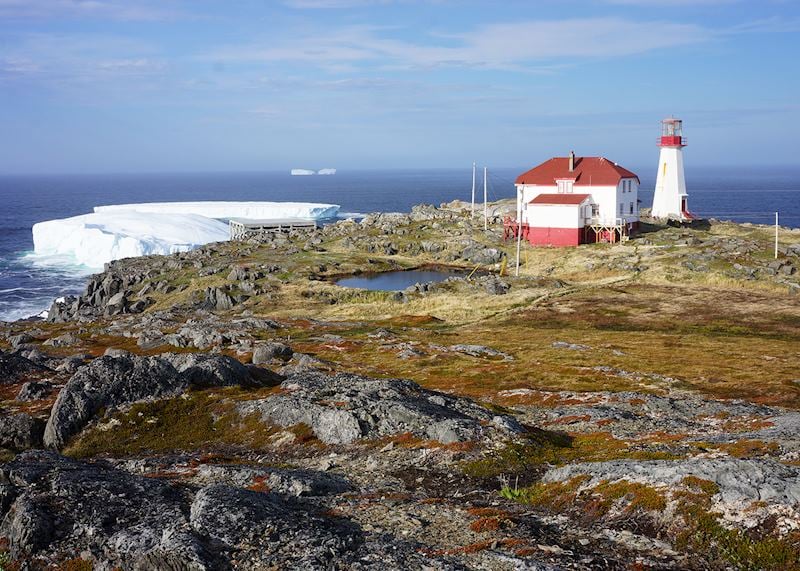
Quirpon Lighthouse has watched over Newfoundland’s remote north coast for over a century, looking out across Iceberg Alley —a stretch of water where ice drifts south from Greenland’s glaciers every spring and summer. The dazzling white ice contrasts with the deep blue waves, as does the lighthouse’s traditional red and white paint.
To get to this isolated, uninhabited island, you’ll need to take a short boat trip from the village of Quirpon on the mainland, or you can kayak across from the mainland if conditions allow. Once there, with no TV or Wi-Fi, you can fully embrace your natural surroundings and the salty sea air.
Your bed for the night lies inside Quirpon Lighthouse Inn, the former lighthouse keeper’s cottage next to the lighthouse, painted in matching red and white. The cottage, and that of the assistant lighthouse keeper next door, has been restored into a comfortable and welcoming inn complete with original wood-panel walls and traditional patchwork quilts. There are just ten rooms in total, adding to your sense of peace and solitude.
While here, you can sit in the indoor whale-watching station on the lookout for orcas, humpbacks, and minke whales, as well as plenty of seabirds. You can also take hikes across the island, pausing to explore an abandoned fishing village, ruins from World War II, and long-forgotten sod huts once belonging to some of the earliest European settlers.
Read more about trips to Canada
Start thinking about your experience. These itineraries are simply suggestions for how you could enjoy some of the same experiences as our specialists. They're just for inspiration, because your trip will be created around your particular tastes.
View All Tours in Canada
